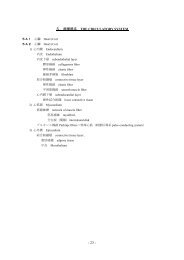Program / Abstract Book - KMU WWW3 Server for Education ...
Program / Abstract Book - KMU WWW3 Server for Education ...
Program / Abstract Book - KMU WWW3 Server for Education ...
You also want an ePaper? Increase the reach of your titles
YUMPU automatically turns print PDFs into web optimized ePapers that Google loves.
No. 53 (PM 2)<br />
HIV-1 RNA viral load in seminal fluid: quantification with NASBA<br />
Lyana Setiawan, Agus Susanto Kosasih, Samsuridjal Djauzi, Haridana Indah Mahdi,<br />
Runingsih<br />
Dharmais Cancer Hospital, Indonesia<br />
As the prevalence of HIV infection increases, the problem of discordant couples with HIV arises.<br />
Although the number is yet unknown, discordant couple presented problem of possible infection to the<br />
mothers and unborn babies. In this study, we assessed the utilization of nucleic acid sequence based<br />
amplification (NASBA) to quantify HIV-1 RNA in seminal fluid, and reported the HIV-1 RNA viral<br />
load in the seminal fluid of patients with discordant couple from the outpatient clinic of Dharmais<br />
Cancer Hospital during July 2010 – February 2012, who have already been successfully treated with<br />
antiretrovirals (ARV).<br />
To determine the usefulness of NASBA, RNA from 2 unprocessed seminal fluid specimens were<br />
extracted using the MiniMag®, amplified by NASBA, and the result quantified. To verify the usefulness<br />
of sperm washing, we processed specimen with high HIV-1 RNA with gradient centrifugation to wash<br />
the sperm, and quantified the viral load in the resulting seminal plasma from first centrifugation, and the<br />
supernatant and sperm from the second washing. After optimization, we evaluated the result of 43<br />
patients treated with ARV who were referred <strong>for</strong> HIV-RNA in seminal fluid test.<br />
HIV-1 RNA was detected in the unprocessed seminal fluid (Pt#1 19,000 IU/ml; pt#2 740 IU/ml), and<br />
in the seminal fluid from the first centrifugation. Supernatant and sperm from the second washing<br />
showed HIV-RNA below detection limit. The result proved that boom extraction and NASBA principle<br />
can be used <strong>for</strong> quantification of HIV-RNA in seminal fluid, and that sperm washing was effective to<br />
minimize the risk of infection in assisted reproduction, but this needed to be verified with more samples.<br />
All 43 patients showed HIV-RNA below detection limit (



